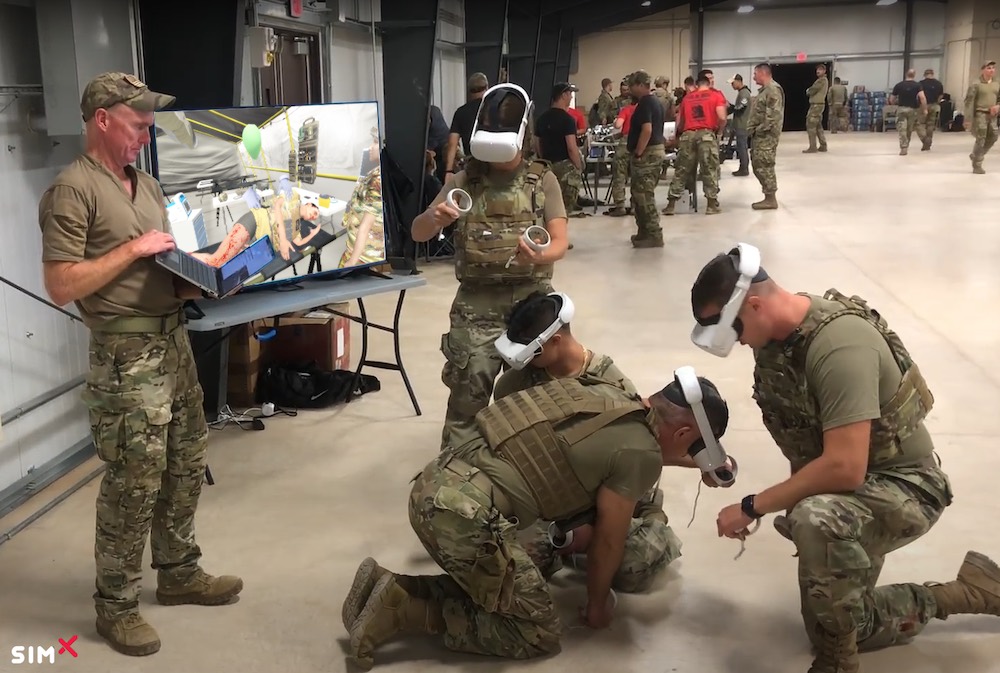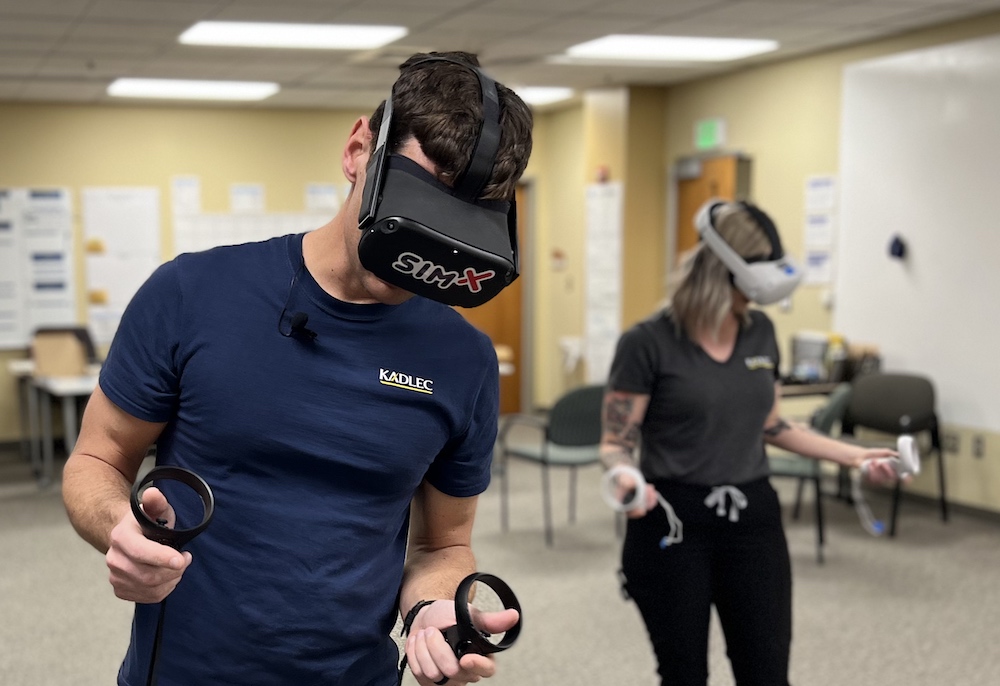The next generation of virtual reality medical simulation training (VR–MST) has been tried, tested, and implemented in partnership with U.S. military medical personnel to increase operational readiness for combat casualty care. In collaboration with U.S. Air Force Special Operations Command (AFSOC) stakeholders, SimX has developed a comprehensive VR solution enabling true-to-life medical simulation training for elite medical military personnel and civilian providers worldwide. SimX’s virtual reality medical simulation system (VRMSS) makes training in immersive, realistic environments with custom patient encounters while incorporating the latest advances in military medical techniques, tactics, and protocols (TTPs) easy for military personnel. This HealthySimulation.com article details how SimX is improving operational readiness for the United States Military.
The system spans the full spectrum of care from the point of injury to Role 4 hospitals. This helps meet the need for medical simulation training that replicates the medical complexity of casualty care. The system is also able to replicate the psychological and environmental stressors of the combat environment, better preparing those in the field.
Using a “train how we fight” approach, the SimX VRMSS boasts over 100 casualty care scenarios with immersive environments, accurate toolkits, and a level of medical realism that reflects the reality of deployed medicine. This military medicine scenario curriculum is focused on Tactical Combat Casualty Care (TCCC) and is used for routine operational training at over 30 Department of Defense (DOD) installations worldwide.
The scenario curriculum was developed through close collaboration between the SimX medical education team and a U.S. Air Force (USAF) team of active-duty medics, nurses, physicians, and educators. Beginning at case inception, this combined team has set standards for creating appropriate medical realism in each scenario that is carried throughout development. Based on the Air Force’s goal to use VR to enable Warfighters to “train how [they] fight,” this approach relies on leveraging unique subject matter expertise across industry and the military.
Underlying the realistic approach is a dual focus on replicating fully realistic medicine and the complex psychosocial and environmental factors of combat. Skills perfected in classroom training may not hold up, for example, in a helicopter during a firefight, when the sounds of combat overwhelm a heartbeat heard through a stethoscope.
To enable faster and easier replication of such challenges, a variety of scenarios have been constructed to practice these stressful, dynamic missions. Such simulations may find learners on a life-saving mission to free and consequently treat soldiers stuck inside a vehicle, with multiple patients in a triage tent, or even in a helicopter treating soldiers while simultaneously running protocols for a successful patient handoff.
Medical simulation training is essential for maintaining operational readiness for combat medicine, especially as the required knowledge, skills, and abilities become increasingly complex. SimX’s growing library of virtual deployed medicine simulation scenarios upholds the medical realism expected for military training and addresses the true needs of learners and educators. In addition to the scenarios being used today for training, SimX continues to expand the available curriculum by creating new content quarterly in partnership with DOD personnel.
Cross-Team Training
Utilizing VR for simulation training can drastically improve how teams work together by allowing multiple distributed teams to train virtually. For example, with the VRMSS, trainees can join a team of medics at the point of injury, pararescuemen in a CASEVAC helicopter, and a forward surgical team at a Role 2 expeditionary facility, all in the same coordinated virtual simulation.
This capability allows Warfighters to integrate combat casualty care training across the roles of care, including communication between roles, patient handoffs and transloads, and identifying and continuing interventions and required care across points in the continuum.
To better accommodate team training, SimX has also introduced non-collocated training. This capability enables multiple teams or providers to train within the same virtual scenario regardless of their physical location – allowing casualty care responders stationed worldwide to train together before deployment. Additionally, with the integrated virtual BATDOK capability, providers can practice using and transmitting care documentation throughout the process.
With non-collocated training, military personnel can choose whether to train with all participants in the same location or to train remotely across multiple sites. This approach contrasts with traditional training modalities (such as manikin or exercise-based simulation), which require all participants to be physically located at the same training facility. Through non-collocated virtual training, Warfighters can realize significant cost and logistical savings, allowing personnel to train more frequently and more effectively together.
VALOR Curriculum
Since its inception in 2020, the Virtual Advancement of Learning for Operational Readiness (VALOR) R&D program’s mission has been to increase the realism and flexibility of VR medical simulation training while dramatically reducing cost and logistical complexity. These goals were deemed critical by the Department of Defense to ensure that U.S. and allied militaries are ready for future conflicts against near-peer adversaries. In such conflicts, casualty rates could be far higher than those sustained during the Global War on Terror, requiring a new approach to maintaining readiness for medical operations.
The VALOR program’s $12M research effort has provided VR curricula covering techniques, tactics, and protocols across the TCCC phases of care. The initial product of the effort was the VALOR CORE curriculum, which is now in active operational use for training across AFSOC and beyond. This curriculum, built on the foundation provided by SimX’s commercial VRMSS platform, also incorporates a wide variety of adaptations to better address the DOD’s operational training needs.
Adaptations completed include functions to support tracking & evaluation, multi-team training, and integrated battlefield documentation. Medical uses cases addressed by the program include TCCC clinical practice guidelines, small unit care, incidents involving weapons of mass destruction, aeromedical evacuation and critical care air transport, astronaut recovery, and more.
Though the initial phase of VALOR has successfully resulted in a mission-ready product now in operational use, the R&D program continues to explore new ways to advance virtual reality medical simulation training capability. Through these ongoing efforts, the Department of Defense and the civilian medical simulation training community will continue to receive the benefits unlocked by the rapidly growing capabilities of virtual reality training.
More About SimX
SimX, previously called SimXAR, is a healthcare software company specializing in medical simulation, virtual reality, augmented reality, and medical training and education. The company brings virtual and augmented reality into the realm of healthcare simulation and training. SimX was founded by physicians in training at Stanford, the University of California at San Francisco, and the University of California at Los Angeles.
They understood that simulation practice and training are extremely beneficial to both learners and clinicians, and hoped to use virtual reality to make simulation cheaper and more accessible, to ultimately reduce medical error and increase patient safety. Seeking to push simulation forward, SimX developed a software system that was the first comprehensive professional-grade VR medical simulation system product available on the market.
Founded in 2013 and headquartered in Mountain View, California, the platform allows medical teams to replace expensive manikins with incredibly flexible simulated patients, backed by a robust case creation engine.








